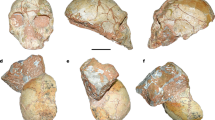Abstract
PARTLY because of their poor fossil record, the relationships of neotropical platyrrhine monkeys to other groups of primates and to each other remain perhaps the most poorly known for any major primate clade1. Here we report the discovery of a complete platyrrhine skull from the Andes of central Chile, by far the best preserved Tertiary primate cranium from South America. This find, coupled with recent phylogenetic analyses of higher groups of anthropoid primates2–4, has the potential to revise substantially our understanding of platyrrhine interrelationships, indicating, among other points, significant modification to reconstruction of the ancestral platyrrhine morphotype and a likely African origin for New World monkeys. A 40Ar/39Ar radioisotopic date directly associated with the skull indicates an Early Miocene age5, marking the first report of South American mammals of this age from outside Argentine Patagonia. Finally, this discovery demonstrates the enormous potential of vastly distributed, but virtually untapped, Andean volcaniclastic deposits to yield further insights into the origin and diversification of South American primates.
This is a preview of subscription content, access via your institution
Access options
Subscribe to this journal
Receive 51 print issues and online access
$199.00 per year
only $3.90 per issue
Buy this article
- Purchase on Springer Link
- Instant access to full article PDF
Prices may be subject to local taxes which are calculated during checkout
Similar content being viewed by others
References
Fleagle, J. G. & Rosenberger, A. L. (eds) J. hum. Evol. 19, iv–254 (1990).
Fleagle, J. G. & Kay, R. F. J. hum. Evol. 16, 483–531 (1987).
Kay, R. F. J. hum. Evol. 19, 175–208 (1990).
Beard, K. C. et al. Nature 368, 604–609 (1994).
Flynn, J. J. & Swisher, C. C. in Geochronology, Time Scales, and Stratigraphic Correlation (eds Berggren, W. A., Kent, D. V. & Hardenbol, J.) (SEPM Special Publication, Tulsa, OK, USA, in the press).
Wyss, A. R. et al. Am. Mus. Novit. 3098, 1–31 (1994).
Martin, R. D. Primate Origins and Evolution: A Phylogenetic Reconstruction (Chapman Hall, 1990).
Gingerich, P. D., Smith, B. H. & Rosenberg, K. Am. J. phys. Anthrop. 58, 81–100 (1982).
Jerison, H. J. Evolution of the Brain and Intelligence (Academic, New York, 1973).
Hoffstetter, R. C. r. Acad. Sci., Paris D269, 434–437 (1969).
Fleagle, J. G. & Bown, T. M. Folia Primat. 41, 240–266 (1983).
Hershkovitz, P. Folia Primat. 21, 1–35 (1974).
Fleagle, J. G. J. hum. Evol. 19, 61–85 (1990).
Rusconi, C. Rev. Argent. Paleont. Antro. Ameghinia 1, 39–68, 71–100, 103–125 (1935).
Tauber, A. Acad. Nac. Ciencias Misc. 82, 32 p. (1991).
Kay, R. F. & Simons, E. L. Int. J. Primat. 1, 21–38 (1980).
Fleagle, J. G. Primate Adaptation and Evolution (Academic, San Diego, 1988).
Pascual, R. & Ortiz Jaureguizar, E. J. hum. Evol. 19, 23–60 (1990).
Swisher, C. C. et al. Science 257, 954–958 (1992).
Samson, S. D. & Alexander, E. C. Chem. Geol. Isot. Geosci. Sect. 66, 27–34 (1987).
Steiger, R. H. & Jäger, E. Earth planet. Sci. Lett. 36, 359–362 (1977).
Taylor, J. R. An Introduction to Error Analysis (Oxford Univ. Press, 1982).
Rosenberger, A. L., Setoguchi, T. & Shigehara, N. J. hum. Evol. 19, 209–236 (1987).
Hershkovitz, P. Living New World Monkeys (Platyrrhini) (Univ. Chicago Press, Chicago, 1977).
Simons, E. L. J. hum. Evol. 15, 205–213 (1986).
Hoffstetter, R. in Evolutionary Biology of the New World Monkeys and Continental Drift (eds Ciochon, R. L. & Chiarelli, A. B.) 103–122 (Plenum, New York, 1980).
De Quieroz, K. & Gauthier, J. A. Rev. Ecol. Syst. 23, 449–480 (1992).
Kay, R. F. & Williams, B. A. Evol. Anthr. 3, 32–35 (1994).
Ford, S. M. in Comparative Primate Biology 1: Systematics, Evolution and Anatomy (ed. Swindler, D.) 73–135 (Liss, New York, 1986).
Rosenberger, A. L. in Ecology and Behavior of Neotropical Primates (eds Coimbra-Filho, A. F. & Mittermeier, R. A.) 9–27 (Acad. Brasiliera Cienc., Rio de Janeiro, 1981).
Author information
Authors and Affiliations
Rights and permissions
About this article
Cite this article
Flynn, J., Wyss, A., Charrier, R. et al. An Early Miocene anthropoid skull from the Chilean Andes. Nature 373, 603–607 (1995). https://doi.org/10.1038/373603a0
Received:
Accepted:
Issue Date:
DOI: https://doi.org/10.1038/373603a0
This article is cited by
-
The Gondwanan and South American Episodes: Two Major and Unrelated Moments in the History of the South American Mammals
Journal of Mammalian Evolution (2007)
Comments
By submitting a comment you agree to abide by our Terms and Community Guidelines. If you find something abusive or that does not comply with our terms or guidelines please flag it as inappropriate.



